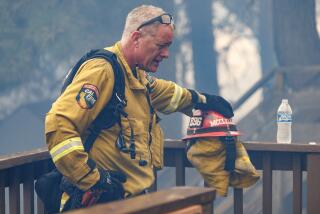State Crews Head to Gulf Coast
- Share via
Responding to a request from the Federal Emergency Management Agency, hundreds of Southern California firefighters and search-and-rescue crews have been dispatched to the hurricane-ravaged Mississippi and Louisiana coasts.
At a Sherman Oaks fire station, where crews were preparing to leave for New Orleans, Los Angeles Mayor Antonio Villaraigosa told reporters Wednesday that he had spoken to Louisiana Gov. Kathleen Blanco and offered her condolences on behalf of the city.
“In Southern California we’ve endured and survived many [disasters],” he said. “But in our lifetime, our country has never seen a disaster of this magnitude.”
Throughout the day, firefighters and other rescue personnel left Los Angeles and Riverside counties on buses packed with equipment that would allow the teams to operate independently during their work in devastated areas. Crews from Orange County and Ventura also were deployed.
“In addition to the swift-water rescue and disaster medical assistance teams, California now has more than 500 people on the road to Katrina now,” said Eric Lamoureux, spokesman for the Governor’s Office of Emergency Services, which organized the response.
Fire officials said the Hurricane Katrina rescue operation represented the first time that Southern California’s four special search-and-rescue task forces -- consisting of personnel from throughout the region -- had been tapped by the federal government since the 2001 terrorist attacks. But Los Angeles Fire Chief William Bamattre said local agencies remained well staffed to respond to any local emergency.
“We all have been watching the devastation and recognize this is not a short-term effort,” Bamattre said. “At the same time, I want to reassure the people of Los Angeles we have sufficient resources here. We’ll be able to respond to any needs here.”
Late Tuesday, Orange County Battalion Fire Chief Mike Boyle and 13 members of his crew joined Los Angeles and Riverside rescue units on three military cargo planes that would take them to the flooded areas of southern Louisiana.
Boyle’s crew has responded to national disasters before, including the World Trade Center attack in 2001 and the 1995 bombing of the Oklahoma City federal building.
But this will be different.
“We expect to rescue people, but there are also wild animals we’ll run across,” Boyle said. “That’s why we’ve brought nooses: for the gators, snakes and [water] moccasins we expect to meet up with.”
Ishmael Messer, assistant chief of the California emergency services office, said reports indicated that 20 square miles of homes and land around New Orleans remained unsearched.
“It’s huge, and [the flood zone] is probably bigger than anticipated,” Messer said.
“We’re being told water is rising an inch an hour in New Orleans, and with the storm moving north to Tennessee, we’re being told it’ll be three to four days before the [Mississippi] river crests down around New Orleans.”
Los Angeles County Fire Chief Thomas Ewald said the California teams were unsure of what challenges awaited them in Louisiana and Mississippi.
“Our concern is what’s going on in the areas we’re not seeing on CNN, in the rural areas,” Ewald said.
*
Times staff writer Catherine Saillant contributed to this report.
More to Read
Sign up for Essential California
The most important California stories and recommendations in your inbox every morning.
You may occasionally receive promotional content from the Los Angeles Times.














